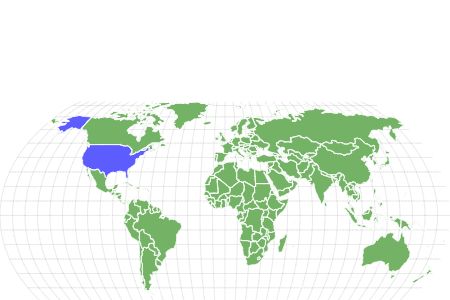Black Wasp
Sphex pensylvanicus
The great black wasp is a species of digger wasp.
Advertisement
Black Wasp Scientific Classification
- Kingdom
- Animalia
- Phylum
- Arthropoda
- Class
- Insecta
- Order
- Hymenoptera
- Family
- Sphecidae
- Genus
- Sphex
- Scientific Name
- Sphex pensylvanicus
Read our Complete Guide to Classification of Animals.
Black Wasp Conservation Status
Black Wasp Facts
- Prey
- Grasshoppers, cicadas, locusts, katydids, and other fleshy insects
- Name Of Young
- Larva
- Group Behavior
- Solitary
View all of the Black Wasp images!
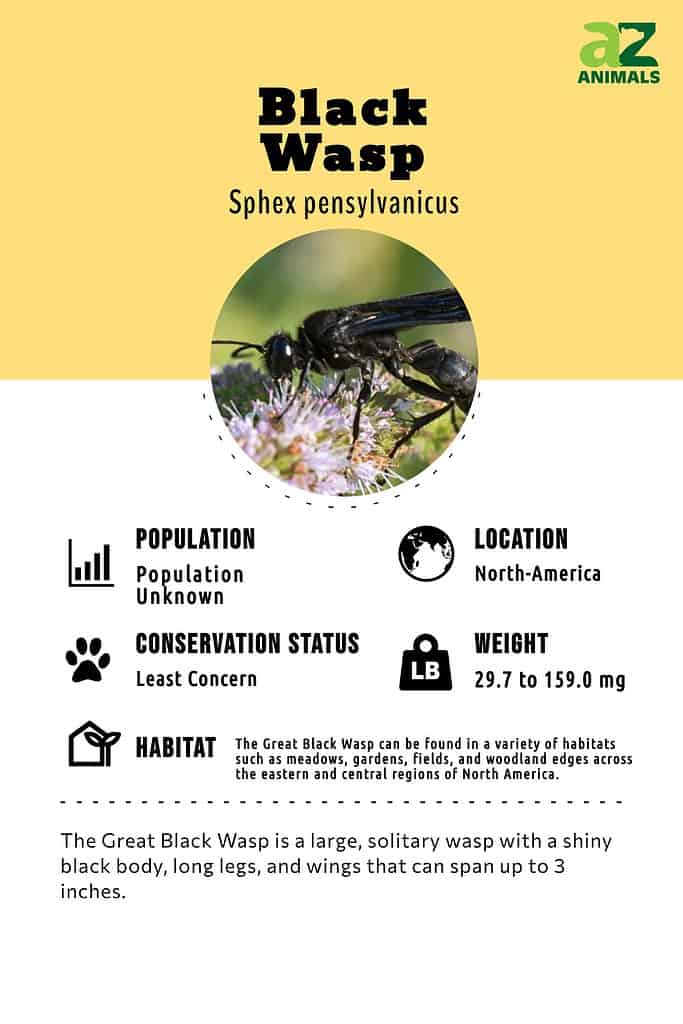
The black wasp, which is often referred to as the Great Black Wasp, is rather small, and it is grouped with other insects under the digger wasp species.
They go by the scientific name Sphex pensylvanicus. They are found all across North America. They are found all over the United States, spanning from the west coast to the east coast. They survive in many different climates because of their adaptability. The western United States is their preferred environment, due to the warmth.
5 Incredible Black Wasp Facts!
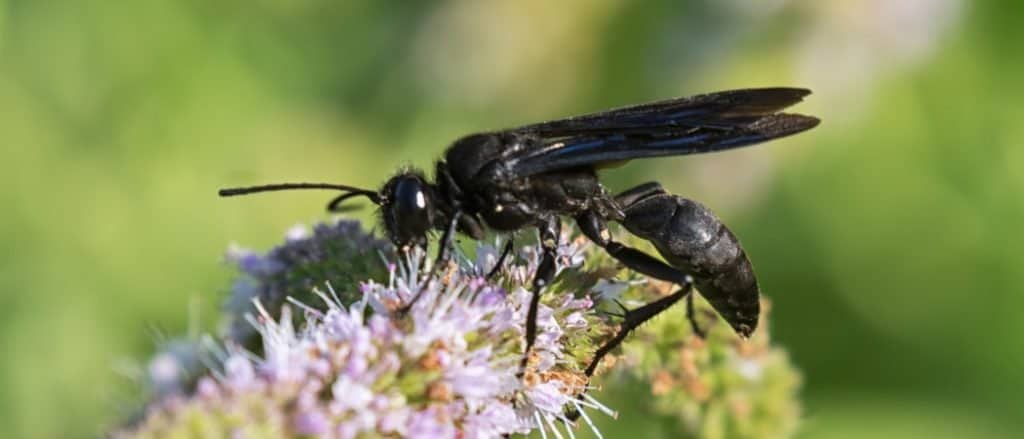
More than twice as large as their male counterparts are the female enormous black wasps. The males, meanwhile, are quite tiny.
©Natalia Kuzmina/Shutterstock.com
Here are a few interesting facts about black wasps:
- The female great black wasps are much bigger than the male great black wasps. However, the males are surprisingly small.
- These insects can grow up to 1.3 inches in length.
- When the Great Black Wasp is stunned, it will appear to be dormant and motionless. However, they are still alive and very dangerous.
- The black wasp is a subterranean insect, which means that they usually stay under the ground.
- They belong to a species of digger wasp.
Evolution and Origins
While the phrase “black wasp” can be used for many different species of wasp, in general, wasps are believed to have evolved from a common ancestor with bees and ants around 100 million years ago during the Cretaceous period.
Black wasps, like all wasps, have undergone significant changes and adaptations over millions of years to fit into different environments and better survive in different situations.
Symphyta, a group of Hymenoptera that includes Xyelidae, was first found in fossil records during the Lower Triassic period. Apocrita, which includes a variety of wasps, first appeared in the Jurassic period and by the Cretaceous period, had developed into many different superfamilies.
They are believed to have evolved from the Symphyta group.
Species, Types, and Scientific Name
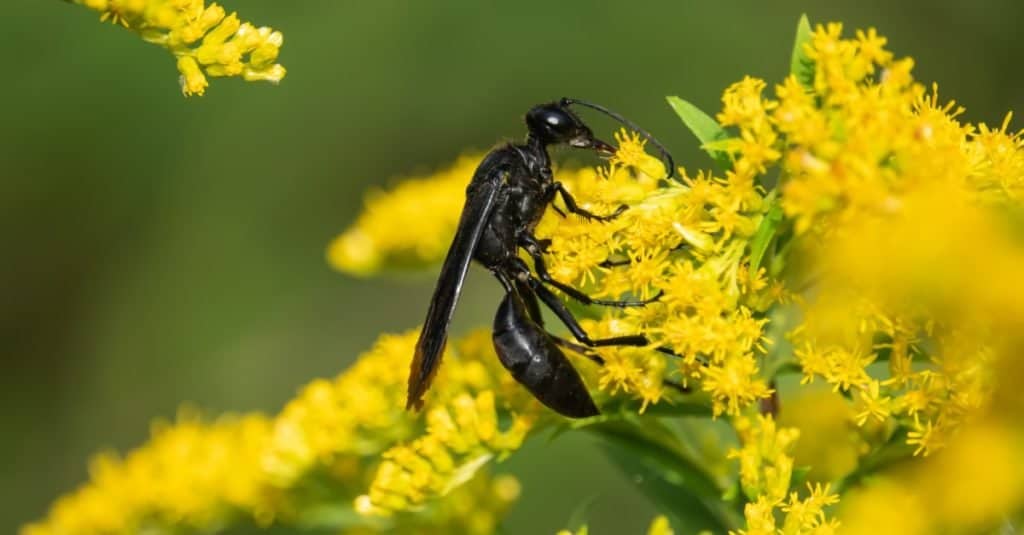
Sphex pensylvanicus is the scientific name for these insects.
©iStock.com/ErikAgar
These insects are known by the scientific name Sphex pensylvanicus. They belong to the species of digger wasp and are known to be found across North America. The females of the species are bigger than the males of the species.The word “sphex” is very direct, and it is the literal word for “wasp” in Ancient Greece. The word “pensylvanicus” is a variation of Pennsylvania, which is an eastern state in the United States. Most often, this word is used to describe a species that is native to Pennsylvania, so it may be included in the name because there are 65 different species of great black wasps in the state.
Different Types
- Asian giant hornet
- Polybia occidentalis
- Common wasp
- German wasp
- Asian hornet
- European hornet
- Vespa affinis
- Red paper wasp
- Polistes canadensis
- Australian hornet
- Vespula rufa
- Eastern cicada killer
- Polistes carnifex
- Bald-faced hornet
- Polistes humilis
- Oriental hornet
- Red velvet ant
- Emerald cockroach wasp
- Synoeca septentrionalis
- Austroscolia soror
- Northern paper wasp
- Synoeca cyanea
- Common paper wasp
- Andricus quercuscalicis
- Chalybion californicum
- Asian paper wasp
- Organ pipe mud dauber
- Pepsis heros
- Megascolia maculata
- European paper wasp
- Vespa simillima
- Blue ant
- Mexican honey wasp
- Euspinolia militaris
- European beewolf
- Evania appendigaster
- Vespa dybowskii
- Vespa ducalis
- Brachygastra lecheguana
- Dolichovespula arenaria
- Eastern yellowjacket
- Blue-winged wasp
- Western yellowjacket
- Diplolepis rosae
- Black-bellied hornet
- Cynips quercusfolii
- Solitary wasp
- Ampulex dementor
- Dolichovespula sylvestris
- Dolichovespula saxonica
- Stilbum cyanurum
Appearance
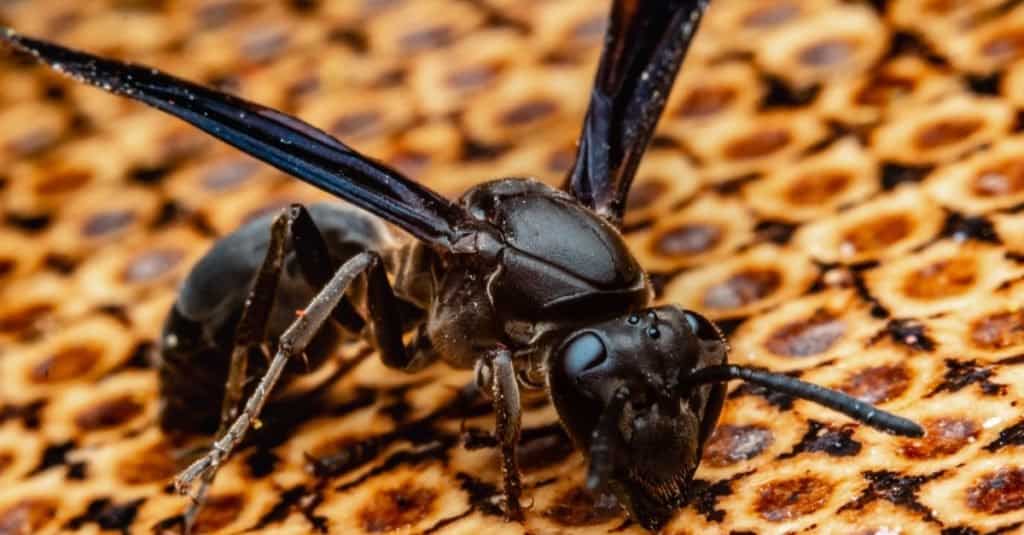
The huge black wasp is, as its name implies, black.
©JULIO CHINAZZO/Shutterstock.com
As the name suggests, the great black wasp is black. Unlike other wasps, these wasps do not have any markings or stripes on their bodies, which makes them relatively easy to identify. These insects have a traditional body for a wasp with large wings and a narrowed midsection in their small body. Their entire abdomen is a deep black hue.
The female black wasp is easily the more unique of the species, showing an incredible size advantage over the male. The species often measures between 1 and 1.3 inches, though the female great wasp protects itself with a powerful and threatening stinger.
These wasps appear to have a semi-gloss black appearance, made only starker by the way that the wings can fold flat onto their body. Their spiny legs can make the insect seem even more intimidating.
These insects are relatively solitary, grouped with other wasps that hunt and sting.
Diet
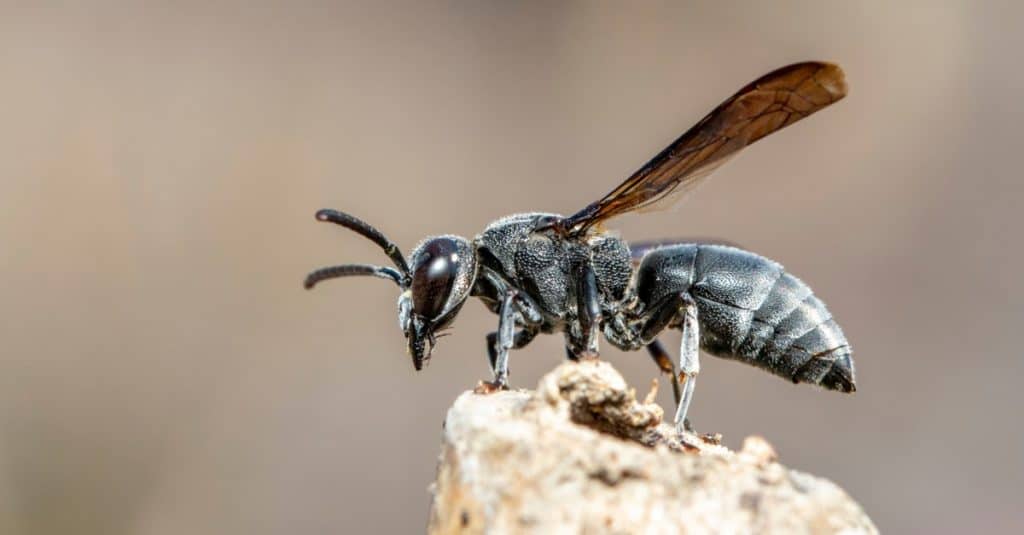
The huge black wasps are insects that live underground, which enables them to establish a home below the surface of their climate.
©yod 67/Shutterstock.com
The great black wasps are subterranean insects, allowing them to make a home beneath the surface of their climate. This area is the best place for them to build a nest and care for their young.
These insects are natural hunters, which is why they will go after grasshoppers, cicadas, locusts, katydids, and other fleshy insects. In some cases, these wasps will also consume their own young before they are ready to fend for themselves.
Prevention

It may be advisable to use a non-insecticide spray to repel these bugs or a nest in the most compassionate manner possible.
©iStock.com/ViniSouza128
As much as co-living in the environment is important, these insects could be a nuisance that is threatening your ability to safely be at home. Leaving them to thrive in the home can cause irritation or discomfort, much like the other insects that might surround you.
For the most humane way to deter these bugs or a nest, a non-insecticide spray may be the best way to get rid of them. This spray stops the insect from being able to fly. There are also non-toxic mint sprays that can be used in the home and garden, protecting plants from damage as well. In some cases, it is possible to use a cleaning spray to saturate the wasps.
If getting rid of it alive is not an option for you, you could hit them with a heavy object. This would most likely kill the wasp. It is important to note that flyswatters do not usually work with the great black wasps.
If you are not scared of the insect, you could pick it up with the help of gloves and can push it into a fly swatter, and then take it outside your home. Interestingly, it could be difficult to determine if the wasp is dead as it can only be stunned and can still be motionless.
View all 285 animals that start with BBlack Wasp FAQs (Frequently Asked Questions)
Are black wasps dangerous?
While the sting of the great black wasp can be painful, these insects are not considered to be fatally dangerous to humans (unless the individual has an allergy).
What happens if you get stung by a black wasp?
Expect to have some allergies, redness, or swelling if you are stung by a black wasp.
Where do black wasps live?
They are found all across North America. They prefer hotter climates, leading them to both coasts.
Are black wasps mean?
No, the great black wasps are known to be solitary insects, but they will defend themselves or their nest if necessary.
How many legs does a black wasp have?
Great black wasps have 6 legs.
How do you identify black wasps?
Black wasps are black and do not have any markings or stripes on their bodies. They have standard wasp bodies. Their wings are large, and their midsection is thin and tiny. They also have a large back end.
How do you get rid of black wasps?
You can use a non-insecticide, non-toxic mint spray or you can kill them with a heavy object to get rid of them.
Thank you for reading! Have some feedback for us? Contact the AZ Animals editorial team.
Sources
- Western Exterminator Company, Available here: https://www.westernexterminator.com/blog/great-black-wasp/
- Field Station, Available here: https://uwm.edu/field-station/great-black-wasp/
- Hunker, Available here: https://www.hunker.com/13406570/how-to-kill-a-great-black-wasp

